Preserving the quality of your food is a great way to live a healthy lifestyle. And with food dehydrators, you'll have the tools needed to remove the moisture from your food. With this guide, we'll show you the ins and outs of food dehydrators so you can utilize them and make tasty food in the process.
The research What Exactly Are Food Dehydrators?Science behind dehydratingBenefits of food dehydratingGreat TasteExtend Shelf Life & Reduce Food WastePrecision DryingCreate 100% Natural and Healthy FoodsSaves MoneyEasy to UseBacteria PreventionCreate Your Own Food LeatherMake YogurtSourdoughJerkyDehydrating Seeds and Crispy NutsVersatile and FlexibleTypes of food dehydratorsVertical Food DehydratorsHorizontal Food DehydratorManual Food DehydratorWhat kind of food should you dehydrate?FruitsWhat fruits?VegetablesMeatHow to store dehydrated food?Food dehydrators maintenance tipsConclusionWhat Exactly Are Food Dehydrators?
Food dehydrators are devices that remove the moisture from food for better food preservation. The food dehydrator uses air and heat flow to take out the water content in your foods. The water content is high, usually up to 80%-90% to some fruits for meats, its around 50-75%.
Removing the moisture from your food restrains bacteria from spoiling and growing in on your food. Also, removing the moisture reduces the weight of your food. Thus, using food dehydrators can help extend the shelf life of certain foods. By removing the moisture, the food becomes more concentrated. There are a lot of culinary techniques that include using food dehydrators.
Usually, most food is dehydrated at 54 °C or 130 °F although protein meats such as jerky can be dehydrated at 68°C or 155°F. At these temperature levels, the dehydrators remove the pathogens that are on the meat.
To properly dehydrate your food, you have to provide a consistent air flow and constant temperature. Too much of a high temperature will harden the food, which leads to food with moist on the inside and dry and hard on the outside, causing it to spoil on the interior.
Science behind dehydrating
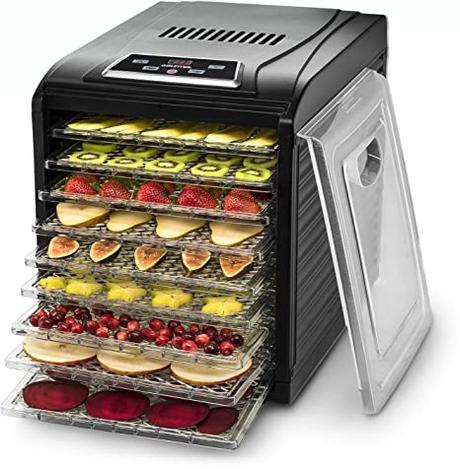
The key to providing a proper food dehydration process is to moisture the temperature quickly, so it doesn't negatively affect the flavor, color, or texture of your food. If the cooking temperature is too low, then the bacteria will survive and grow on your food before it dries.
However, if it's cooked at a high temperature with low humidity, then the food will become hardened on the surface. This makes it hard for the food to dry correctly or lose moisture. Using a trial and error approach is the best way to to find out what dehydration techniques are needed based on the model of your machine.
Food dehydration can take a significant impact on the weight. Here is the average weight reduction of certain fruits using food dehydrators:
- Carrots - 0.8 kilograms (1.75 kilograms)
- Peaches - 1.5-2.5 lbs (0.7 - 1.1 kilograms)
- Plums - 2.25 pounds (1 kilogram)
- Tomatoes - 0.75 lbs (0.3 kilograms)
Benefits of food dehydrating

Because of its various health benefits, it’s a no brainer why food dehydrators are so popular. Here are some reasons why you should start using food dehydration as a way to process your food.
Great Taste
Food dehydrator removes moisture from your food such as meats, vegetables, fruits, and creates naturally rich, concentrated, and delicious food. But when you're making food on your own, you'll know the freshness and quality of the food you're using - unlike dehydrated foods that are bought from the grocery.
Extend Shelf Life & Reduce Food Waste
You never have to waste food with using a food dehydrator. Using your vegetables and fruit will extend the shelf life by up to 2 years. Below are some ways to help you reduce waste by keeping your pantry stocked while saving you some money in the process.
- Save some foods that would spoil otherwise.
- You can buy in bulk food that will save your family money. For instance, mangoes that are bought in the middle of summer, and have mango smoothies during the winter.
- You can make a bigger herb garden without worrying about your food going to waste. Simply use your dehydrator to make veggie chips or dry out your herbs. Vegetables that work include beetroot, carrots, turnips, green beats, and even sweet potatoes.
You can "re-hydrate" you dehydrated food by using water or adding it to soups, straws, pasta, sauces, or casseroles.
Precision Drying
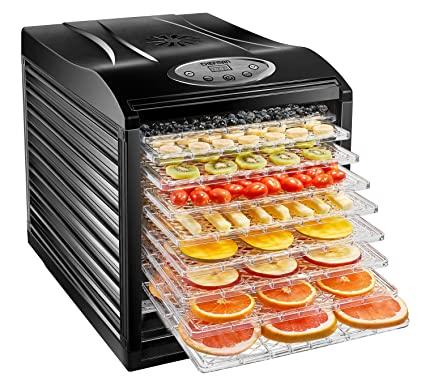
If you've tried dehydrating food on the oven, then you'll know the difficulty it causes. This is not only due to the higher electricity costs, but most ovens won't start up their temperature gauges under 90 degrees Celsius.
When using food dehydrators, you can have control over drying food in low temperatures. Besides being cooked at low temperatures, food dehydrators can be "raw food." Having a raw food diet provides a lot of benefits, and can preserve the life of the vegetables and fruits instead of the heating process, which is known to eliminate the nutrients over time.
If you are planning to eat more raw foods, a dehydrator is a great option for preparing food under 46 Celsius. This is the threshold temperature where the nutrients or enzymes are maintained - more than other kitchen appliances found in the market.
Create 100% Natural and Healthy Foods
Dehydrated foods require one ingredient, since the food is drying, you benefit from the fiber and materials of the fruit, unlike steaming and cooking. So you don't lose the conditional value of the food you're dehydrating.
Dehydration is a way to change the appearance of your food. Simple vegetables and fruits can be transferred to treats and healthy snacks. There are an endless amount of possibilities of how much healthy foods you can make with a dehydrator. You'll be surprised at the amount of dehydrated food you can make - dried herbs, dates, sultanas, etc.
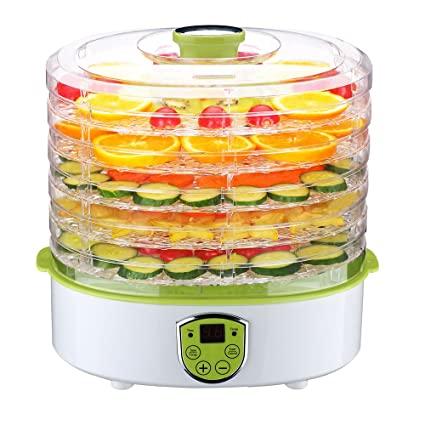
Sulfur Dioxide is added to food in supermarkets and stores to stop discoloration. It can cause stomach pains, skin rashes, and asthma. You can find sulfur dioxide in dried apricots, which is why it has an orange color.
By making dried fruits, there are no preservatives or additives; you have full control over your food. If you're wondering for a simple way to give your family snacks, food dehydrators is your answer.
Saves Money
Buying processed snacks can be organic, and expensive foods are very overpriced. You can save a lot of money by harvesting produce, and buying fresh food in bulk once its in season. So utilize the deals from your local farmer's market or local grocery store so you can dehydrate them and use them in the future.
Easy to Use
Food dehydrators are foolproof. With its set and forget system, you can prepare your food by cutting into pieces, placing it in trays, setting up a timer, and waiting until it finished the dehydration process.
And you'll like that the temperatures are low, so its difficult to overdry the foods. In the event that you do overdry your food, you can rehydrate it by adding water or adding them to your soups, pasta sauces, or casseroles.
Bacteria Prevention
Unlike other preservation methods (and because food dehydrators van remove the moisture of food), the risk of bacteria spoiling your food is very low. In fact, food dehydration methods can are used by hikers, astronauts, and campers because of their safe preservation methods.
Create Your Own Food Leather
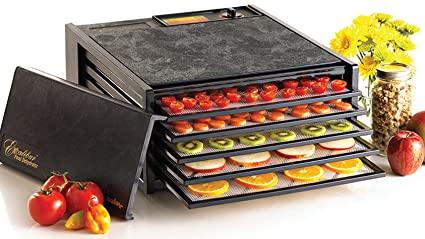
With food dehydrators, you can make your own snacks and fruit leather. We suggest that you use a nonstick sheet to help with removing it easier.
Make Yogurt
While you could purchase a yogurt maker, it's only going to take up space and be used for one task. With food dehydrators, you can create multiple yogurt jars. Although the temperatures might vary due to the culture, having the temperature at 110°F will make the yogurt properly.
Tip: You can make individual servings of yogurt by placing them in half-pint canning jars. You can use dehydrator trays to make the most yogurt in a cycle.
Sourdough
Did you know that you can make your own sour dough with food dehydrators? Generally keeping it at a 75-80°F setting works the best. If the thermometer doesn't have this low-temperature setting, then you can remove the dehydrator door.
Make sure to check the temperature setting of your sourdough via a handheld thermometer, to prevent your sourdough starter from overheating.
Jerky
Making jerky is easy when using a food dehydrator. To make jerky, using strips of tofu, sliced meat, or kombucha scobys. The metal and plastic trays are sufficient and can handle the food that's being processed.
If you’re using ground meats, then you should use unbleached parchment paper or non-stick sheets.
Dehydrating Seeds and Crispy Nuts
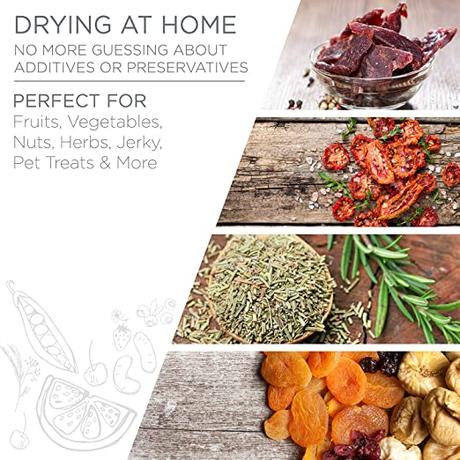
Dehydrating nuts can reduce enzyme inhibitors and phytic acid that prevent nutrient absorption. Nuts can be soaked in salt water and should heat up at 150°F for up to 24 hours.
Bonus: Dried and soaked seeds and nuts tend to taste better.
Versatile and Flexible
Whenever you want to make veggie chips, food dehydrators give you the flexibility to do so. And you’ll have the option to use it for a period of hours, or multiple days. Here are some things you can make with a food dehydrator:
- Healthy animals and pets can eat treats without preservatives.
- Vegetable chips - You can create chips out of carrot, sweet potato, beetroot, without oil
- Dried fruit like strawberries, blueberries, bananas, mangoes, kiwi, and pineapple fruit.
- Bread alternatives such as crackers, flax seed bread, and pizza bases.
- Jerky - You can experiment with multiple varieties such as fish, beef, lamb, poultry, with fresh free spices and marinades.
Types of food dehydrators
Vertical Food Dehydrators
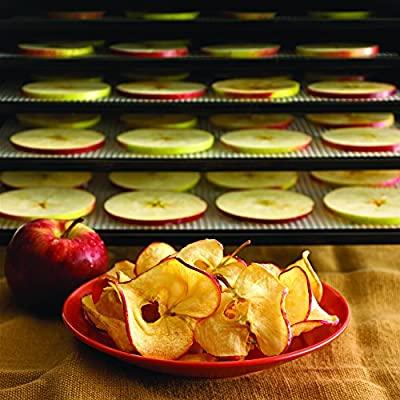
The most common food dehydrators are vertical, or stackable food dehydrators. They have a heat source that's placed on the top of the food processor or on the base.
Vertical food dehydrators are the most affordable options, but this is because their heat doesn't spread uniformly. Some vertical flow models have a fan to help with heat distribution. They work best on fruits and vegetables, but it will be difficult to heat up meat like jerky unless you're willing to change trays during the dehydration process manually.
ADVANTAGES
- Small and compact. They can be stored easily, and they don't take up too much counter space.
- Expandable. Most dehydrator shelves come with more shelves you can add over time.
- Affordable
DISADVANTAGES
- Uneven heat unlike horizontal models.
- Expandable. Most dehydrator shelves come with more shelves you can add over time.
- Suitable for fruits and vegetables, but not meats.
Horizontal Food Dehydrator
Shelf tray dehydrators or horizontal food dehydrators, work more like conventional ovens. It has a heating source located on the back, making it easier to dehydrate evenly.
This is a more expensive model than the vertical dehydrators, but they have a better heating quality than vertical devices as well. If you’re trying to cook meat, then you should get this device. This makes it easier to use because you can let the foot sit in the heater without having to do any manual work until the food is properly dehydrated.
ADVANTAGES
- Efficient and clear drying throughout the food.
- Can be used on tougher vegetables and meats.
- Simple to use. Once it’s on, there’s no manual work that’s required.
- Use more ambitious recipes
DISADVANTAGES
- They are more expensive
- Large size. They need more counter space than vertical food dehydrator.
Manual Food Dehydrator
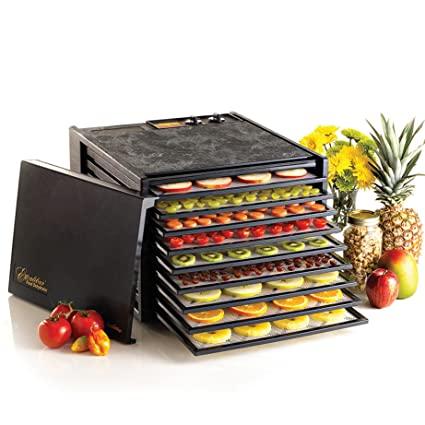
Air drying is an option that most DIY users prefer. There are a lot of online resources available that can help you get started with making your own dehydrator. This is the most economical option, as it allows users to control the heating and movement along with the elements.
ADVANTAGES
- Manual heating control
- Most economical option
DISADVANTAGES
- Hard for beginners
- Difficult heating
Depending on your cooking needs (snack creation, dehydrating meats, etc.), you'll find a dehydrator that works for you. If you are looking for a simple, go for a stackable dehydrator. But if you're accustomed to a dried food diet, then horizontal food dehydrator is a great option.
What kind of food should you dehydrate?
Fruits
You can make a fruit puree and fruit leather user food dehydrators. Place it inside a ⅛ inch thick parchment or in a lined tray sheet. Dehydrate the fruit at 140 degrees Fahrenheit for over 6 hours. You can use syrup or honey to sweeten it, and you can test the fruit for tackiness as you go.
What fruits?
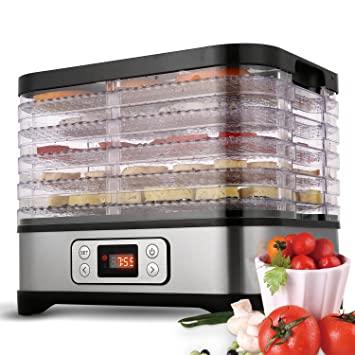
Before you start with dehydrating fruits, let's start with the basics. Mangos, sliced apples, apricots are all good fruits if you're dehydrating food for the first time. Make sure the fruit pieces are sliced ¼ or ⅛ inches thick.
Vegetables
The dehydration process with vegetables is similar to drying fruit. The drying tends to concentrate on the natural sweetness on vegetables and with a bit of seasoning and salt if they are chips.
Try peppers and tomatoes to have a chewier snack as well. Depending on the food’s moisture content, this will take around 6-12 hours.
What vegetables?
With vegetables, it's best that you either steam or blanch them at first. You can dehydrate vegetables such as onions, mushrooms, and others without having to pre-cook it. Like fruits, you need to slice the vegetables in ¼ or ⅛ inch thick pieces.
Once the vegetables are dried, you can store your food in containers, vacuum seal bags, or jars. After the vegetables are exposed to the air, the food can be enjoyed within two weeks. Your shelf's stability depends on the moisture that's left in the food. If you do notice any signs of molding, don't hesitate to discard the vegetables.
Meat
When it comes to dehydrating meat, you aren’t limited to just jerky. You can try using pre-sliced turkey, beef, ham. Also, you can use dry fish, like salmon.
How to dehydrate meat?
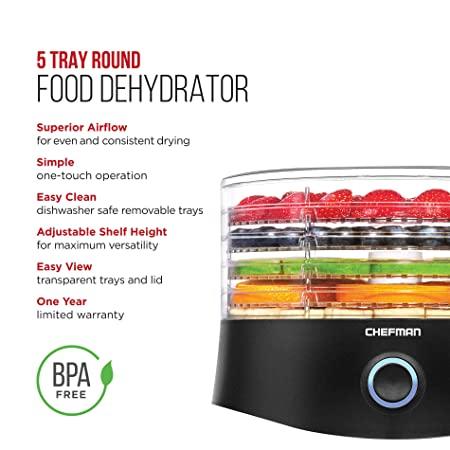
Meats and jerky need a high heating temperature for proper dehydration. Meat can be cooked at a 160 degrees Fahrenheit, so you should preheat the dehydrator for at least 30 minutes, before starting.
The temperature of the meat needs to stay at 160 so it can dehydrate properly. You can do this by drying it for 4-6 hours inside the dehydrator. After that, cook it for at least 10 minutes. Or keep it at a 160 degrees before you start dehydrating it for about 4-6 hours.
How to store dehydrated food?
When you are storing dehydrated food, there are some important procedures you must follow. Gain personal satisfaction by handling and storing dehydrated food well. Here are some good tips to help you manage food that’s been dried or dehydrated.
Store Only Small Amounts
This is because if the containers are fully opened, then it will be exposed to the air. As a result, the food quality will worsen, and it will become filled with moisture. You need to check the food once you've stored it after all.
Store it In a Dark, Cool Area
High temperatures equals lower storage time. Keep in mind that dried fruits can last for 6 months when stored at 80 degrees, and a year when stored at 60 degrees.Whether its venison, jerky, or beef, make sure that you store it in a fridge or a freezer to get the best results.
Handle the Food for Storage
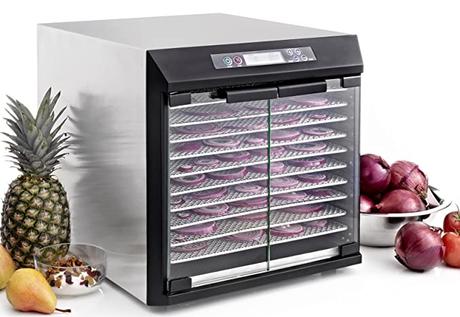
Storing your food is just as important as dehydrating it. Don't leave the food in room temperatures for more than a few hours. Check the cleanliness of the refrigerator and the food container before dehydrating another batch of food.
Food should not go under 40 degrees when its placed in the refrigerator. Check your food storage usually, and then use a “first in, first out” process when storing your dried food items.
Label Food
Make sure that your dehydrated food is labeled correctly. You need to include the date, botanical name, and other information needed to organize the food in your fridge. This is important if you've placed your food inside of an opaque jar.
Get Your Food in the Highest Quality
Dehydrated food will stay stable depending on the quality you've bought it from. Select clean and ripe products with no sign of insect damage or spillage. Check the products found in local stores to ensure that there's no tampering and notice the dryness factor of your foods. The cans need to be intact as well.
Get a Moisture Free Place
Moisture is a big threat to the quality of your food. So once your food has been dried, place them inside dry containers. Get a tight fitting lid for the container, so that no moisture enters the food or air that can reduce the quality.
Food dehydrators maintenance tips
Keeping your food dehydrator clean will increase the chances of it performing correctly and lasting longer. If you start neglecting your machine, how do you expect your food dehydrator to work when you need it to?
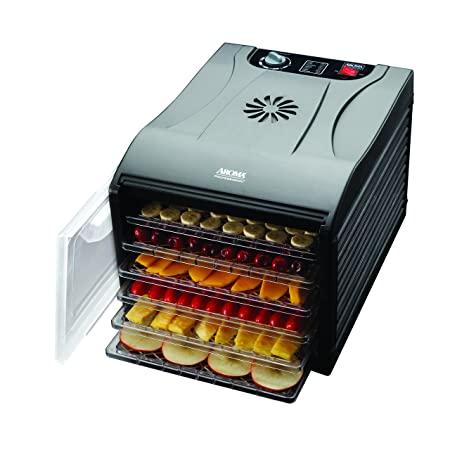
Honestly, it’s easy to keep your food dehydrator clean. Like most dehydrators, they are safe to be placed in the dishwasher. Once you’re done making a batching of your favorite food, you can take off the parts and place them inside a dishwasher.
One problem is that food can get stuck on the trays and placing them inside the dishwasher might not be enough to remove the dried food contents remaining.
When you are dehydrating food, you are taking away the moisture, and the natural sugars are condensed and more sticky. Remember, that food item can stick on your dehydrator, so take the time to rinse it off before placing it in the dishwasher.
Dehydrator trays tend to be fragile, so you can’t use harsh solutions to clean it. First, you’ll want to let the trays stay soaked in hot water. This will rehydrate the food and dissolve sugars, which breaks the bond it has with the tray.
After the trays have been soaked for a few hours, some gentle scrubbing is needed to get the particles off. Then you can place it in a dishwasher and wash the dehydrators by hand.
Conclusion
To conclude, food dehydrators are a great addition to your kitchen as they allow you to make snacks, preserve food, and increase the lifespan of your fruits and vegetables. However, you might need to find the dehydrators based on your budgets.
We invite you to look at our buying guide. Here, we’ll review the top food dehydrators in the market that would be a great addition to your household. So if you’re ready to get the best food dehydrators in 2020, we suggest you give it a look.
Sources
scienceofcooking.comkitchenchatters.comeasy-food-dehydrating.comthetinylife.comlearn.compactappliance.com